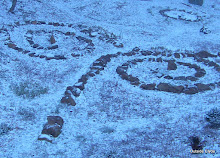I see wild flowers and covet them even when a close inspection should tell me I don't have the right conditions for them. It's a terrible thing. Two I am seeing of late are growing on brutally mowed, down to the dirt, steep, dry slopes. I barely mow. I certainly don't do it brutally. Bare dirt lasts a few seconds at best with my Lush.
I left the Erigeron pulchellus to be wild elsewhere. I visit often enough while it is in bloom.
I couldn't pass up on the Bird's Foot Violet. I had one for three years and it bloomed well for me. It did not make babies that I know of. This violet only spreads by seed. I think a damn varmint ate it. I am finding the root and tuber eating varmints were quite busy over the winter.
So I acquired some more Bird's Foot Violets (plural) and planted them in the driest, crappiest, as close to bare dirt ground in full sun that I have. I hope they like it and make babies. No brutal mowing will be involved however. They will have to deal with thin Lush.
I have the conditions that favor trilliums. I should be-am content with that. I did not plant this Trillium erectum in my garden. I edited and it appeared or more likely was uncovered. This is the least common trillium in the wild cultivated gardens.
I did not plant the Jack-in-the-Pulpits. There are hundreds. They come in three colors and small, medium and large.
The wild elements of the garden are very bit as interesting as the cultivated parts. My editing favors their spread.
I relocated some Trillium grandiflorum into the garden from the stream valley on the other side of my driveway. They have settled in and have started to multiply like their kin in the deep forest. I have a ways to go to catch up to the vast sweeps of them in the forest.
A red leafed Japanese Maple among Mayapples. This is a wild cultivated garden.
Does this look luteum to you? It did get some luteum last year right before it faded away. Of my store bought trilliums this has at least multiplied to three. All the others are still one. I'm a bit concerned at the moment that two more recent store bought trilliums may have been eaten by the root and tuber snatchers. They may still come up.
What I discovered on my stroll late this afternoon was four hosta that had their underneaths completely or partially eaten. The budding crowns lifted right out of the ground. Below them was a warren of caverns. The rootless budding crowns were sitting on air. Damn varmints.
Next time someone says hosta are useless for native wild life you can call them on it. In an ocean of wildness, I have a clan of hosta eating voles. Damn varmints! They ate a couple of my experimental Hesperaloe too.
But I have faith in the Lush. The abundance in the wild cultivated gardens is beyond measure. A few losses can be tolerated - with mild cursing.
Subscribe to:
Post Comments (Atom)
















4 comments:
Voles eat everything. Your trillium collection is admirable.
Lisa I would be fine if the voles assisted in thinning some of the goldenrod.
I like your lush better. I've seen all of these & miss them.
Lola my Lush certainly has a lot more going on than a brutally mowed dry slope.
Post a Comment